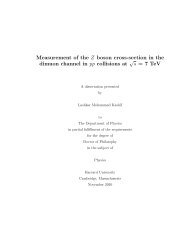2 The CDF Experiment at Fermilab Contents - Harvard University ...
2 The CDF Experiment at Fermilab Contents - Harvard University ...
2 The CDF Experiment at Fermilab Contents - Harvard University ...
You also want an ePaper? Increase the reach of your titles
YUMPU automatically turns print PDFs into web optimized ePapers that Google loves.
Section 2: Run II Triggers 79<br />
2.4.5 Multijet Trigger for W=Z + h<br />
(Prof. Huth, Dr. Maksimovic, Dr. Riegler & Mr. Medvigy)<br />
In his search for the Standard Model Higgs boson produced in associ<strong>at</strong>ion with a vector<br />
boson (W or Z) in the Run I multijet d<strong>at</strong>a, Jorge Troconiz (then a post-doc in our group)<br />
encountered problems with the old multijet trigger. <strong>The</strong> trigger was optimized for tt ! 6<br />
jets, and involved only the second level of <strong>CDF</strong>'s three-level trigger system. In Run Ib, the<br />
multijet trigger had to s<strong>at</strong>isfy the following criteria:<br />
<strong>at</strong> least four Level 2 calorimeter clusters with E T > 15 GeV<br />
total Level 2 calorimeter energy (sum over all clusters) P E T > 125 GeV<br />
<strong>The</strong> fundamental challenge for Troconiz's Higgs search was th<strong>at</strong> the above criteria were<br />
r<strong>at</strong>her inecient for the light SMHiggs. Furthermore, the trigger eciencies for H + W=Z<br />
signal corresponding to Higgs masses between 90 and 140 GeV (th<strong>at</strong> the search considered)<br />
were found to vary signicantly { i.e., the Run I search ended up right on a steep part of<br />
the trigger eciency curve.<br />
In this situ<strong>at</strong>ion, there clearly is room for improvement, and the n<strong>at</strong>ural place to do so is<br />
in the calorimeter requirements of the multijet trigger. Professor Huth initi<strong>at</strong>ed this project<br />
by advoc<strong>at</strong>ing the idea of using displaced tracks found by the secondary vertex tracker (SVT)<br />
P as a means of controlling the increase in the trigger r<strong>at</strong>es caused by the lowering of the E T<br />
requirement.<br />
In the redesign of the multijet trigger { so th<strong>at</strong> it is appropri<strong>at</strong>e for a H + W=Z search<br />
{ our goal is to dene trigger criteria th<strong>at</strong> are ecient for the type of events we would like<br />
to collect after all selection cuts, including both trigger and oine. For instance, in order to<br />
form the invariant mass of a Higgs candid<strong>at</strong>e, we need to be able to identify the b jets in a<br />
multi-jet event; therefore we expect th<strong>at</strong> we will have to employ some form of b-tagging. <strong>The</strong><br />
events th<strong>at</strong> fail the oine version of the b-tagging (currently approxim<strong>at</strong>ed by SECVTX)<br />
are therefore of no use for us, and we ignore them while tuning the multijet trigger. We<br />
therefore try to<br />
1. keep the eciency of two b-tags <strong>at</strong> the oine level as high as possible;<br />
2. keep the trigger r<strong>at</strong>es (domin<strong>at</strong>ed by background) as low as possible.















